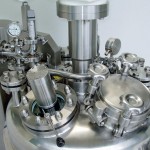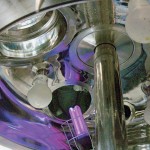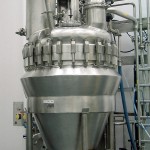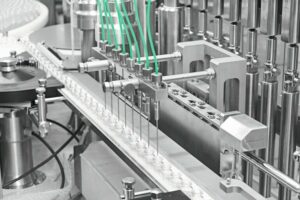When the development department of a pharmaceuticals manufacturer wants to test steps for producing a new active ingredient, only small quantities are usually available. Nonetheless, laboratory machines must provide data that can serve as a basis for the design of production equipment. For this reason, AVA now offers its vertical cone dryers in pocket format.
Silver Anklin
Be it through conventional or biological synthesis, the pharmaceutical industry trend towards more active products continues. Apart from being highly active, these products are costly, often delicate and only available in small quantities. Suppliers of equipment for the production of pharmaceutical actives have to take this development into consideration when they design their test machines.
Even well appointed equipment suppliers’ laboratories lack the necessary installations for adequate handling of highly active compounds. It follows that trial series with such products can only be conducted at the premises of the products’ manufacturers.
For this reason, trial equipment must be highly mobile and easy to operate, and it must allow residue-free cleaning. In addition, insights into the process gained with small machines must be applicable to the design of bigger production units.
At Achema, AVA-Huep will present a laboratory dryer for pharmaceuticals which will also be made available as a rental unit.
Hassle-free scale-up
Vertical cone dryers offer the advantage of complete discharge. The top-driven helix is mechanically simple and not prone to failure. It permits a shaft seal without product contact and an entirely closed system, ideal for nearly perfect containment. The conical vessel also offers great filling volume variability.
It goes without saying that the treatment of welds and surfaces and the configuration of static seals are in line with valid GMP guidelines. In order to allow easy access to the dryer’s interior for inspection and cleaning, the machine’s top head can be raised by a motor-driven hydraulic lifting column. The design allows operation with solvents and powder mixtures in conformity with Atex directives.
Cone dryer solves the dilemma
Information from trial inquiries and discussions with development staff have shown that, due to inadequate production capabilities during the development phase and high production costs, five litres of material is often the maximum that can be produced and made available for evaluations. On the other hand, engineering departments demand a simple and reliable scale-up to common production sizes. With its ingenious design, the vertical cone dryer is the solution to this dilemma. Thanks to the dryer’s conical shape, representative statements can be made about a product’s drying behaviour at filling levels equivalent to between 10 and 20 % of net capacity. A scale-up from 25 l to the pharmaceutical industry’s production capacities of 100 to 1000 l is altogether realistic. The dryer was conceived as a trial machine for the development of active ingredients. To facilitate integration into closed systems, all nozzles are equipped with standard clamp flanges in accordance with DIN 32676. With their help, the user can create airtight connections from charging and discharge nozzles to valves and containers, and attach split butterfly valves to obtain maximum containment conditions.
Simple cleaning
After any trial with a potentially highly active ingredient, even traces of it have to be removed before the installation can be used for another product. Responsibility for cleaning lies with the client who performed the trials. To keep the effort required for cleaning reasonable, the machine and its accessories are specifically constructed for this purpose. Flooding with an appropriate cleansing liquid is usually good enough to remove residues from a product compartment manufactured to GMP standards. More critical are product-wetted compo-nents such as the discharge valve, vapour filter and shaft seal. The ball segment discharge valve is CIP cleanable with built-in spray nozzles, simple to remove thanks to a clamp connection to the dryer and can be completely disassembled without tools. The dust filter is a textile sleeve built into a smooth, easy-to-clean housing. Once wetted, it can be removed and replaced by a new one for trials with another product.
Mechanical seals commonly used for pharmaceutical dryers cannot always be cleaned in a way that guarantees the removal of all product traces. This is why high-grade lip seals were selected as a GMP quality sealing device for the agitator shaft, if necessary made of perfluor elastomers. After lifting the dryer’s top head, the helical agitator can be extracted downwards. The shaft seals can be removed and the sealing area becomes accessible for thorough cleaning. To be on the safe side, lip rings are replaced before new trials with another product. Dryers available for sale can of course be furnished with mechanical seals of a client’s choice.
Liquid product processing
In addition to their standard task, namely drying filter cakes as well as various mixing jobs, cone dryers with a helical agitator are also suited for processing liquids. They are often used as evaporators, and sometimes as reactors. Here, being able to operate the dryer at increased pressure is an advantage. To make use of this possibility, the AVA dryer is designed for a pressure of 4 bar. Some clients like the option of dry-ing biological materials, for example, at low product temperatures by operating the dryer, as an alternative to time consuming freeze drying. Thanks to a built-in sampling device, product samples can be taken while operating under vacuum or under pressure.
The dryer is mounted onto a polished stainless steel base, which is mobile on anti-static casters. The control system, with buttons for controlling the agitator drive and lifting column as well as displays for agitator speed, power consumption, product temperature and pressure, is designed for operation in Atex Zones 2/22. All valves are manually operated. The dryer vessel is heated with a conventional jacket and insulated. To prevent condensation when drying water moist products, the top head and filter housing are heated through milled channels. All standard heat transfer media, such as water, steam or thermal oil, can be used. A suitable heating device is supplied with the unit on request.
Hall 6.0, Booth D26
Online-Info www.cpp-net.com/2209461
Share:









